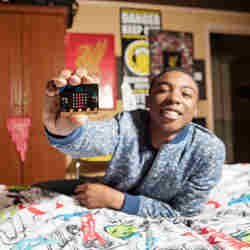
Companies are not just talking about the importance of engaging students in computer science and learning to code; they are doing something about it. In March, the British Broadcasting Corp. (BBC) rolled out its micro:bit computer to almost one million middle-school students in the U.K., for free.
The impetus was that the U.K. currently faces a critical skills shortage in the technology sector, and the BBC and its partners want to help change that, says Sinead Rocks, head of learning at the network. "It’s designed primarily to introduce young people to coding and computer skills, but also for them to explore their digital ideas and to get creative."
The micro:bit comes with 25 red LEDS, two programmable buttons, a built-in compass, an on-board motion detector, and Bluetooth Smart Technology, she says. It has five Input and Output rings so the micro:bit can be connected to other devices or sensors, enabling users to enhance and adapt the micro:bit themselves. The technical specifications for the device will be open sourced to help with its further development.
The micro:bit was designed to encourage children to move away from seeing laptops and tablets as "devices you can do things on" and perceive them instead as "devices you can use to make other things happen," Rocks said, "a concept that has arguably been lost to many, as so many types of technology have become ever more intuitive and easy to use."
Raspberry Pi is another U.K.-originating, low-cost computer the size of a credit card, which plugs into a computer monitor or TV and uses a standard keyboard and mouse. It was developed as a way to teach computing to people of all ages and to help them learn how to program in languages like Scratch and Python.
The new flagship $35 Raspberry Pi 3 launched at the end of February, generating sales of almost one million units, with nearly nine million Raspberry Pis sold to date. About 80% of sales have come from the U.S., notes Eben Upton, CEO of the non-profit organization.
The Raspberry Pi is built on Linux, with a quad core 64-bit processor and Bluetooth in version 3. It is mainly used in grades 6 and up, although some younger children can also use it, says Upton, who is also a chip architect at Broadcom.
The Pi has a camera peripheral, and one of the more interesting things people are doing with it is putting the unit on balloons and sending them into space to take pictures, he says. "A school can have a space program for a couple hundred bucks,’’ he notes. "Space is pretty hot right now. There’s a lot of exciting stuff going on, and it’s nice for kids to be able to be part of that."
The micro:bit also has had space adventures. Twenty students from the Rishworth School in West Yorkshire, along with their teacher, sent their homemade space probe over 100,000 feet (about 20 miles) into the air using a helium balloon, says Rocks. "Their probe, consisting of a BBC micro:bit, two Raspberry Pi computers, and an tiny Lego astronaut pilot, was programmed to take pictures of the Earth, all at a minimum temperature of -47.9°C."
The newest kid on the cheap computing device block is the $9 C.H.I.P. computer, which began shipping in December 2015. In May, the company started shipping its hand-held device, the Pocket Chip, and an adapter, says Richard Reininger, vice president of marketing at parent company Next Thing. C.H.I.P. is also built on Linux and, like Raspberry Pi, requires a television in order to see what is going on.
Reininger says Next Thing is able to offer the low-cost devices by finding available components that were not in use. "We talked to vendors and started to buy them up in large quantities since they didn’t have anyone else to send them to, and we put them on a board and we hit our price point,’’ he says.
As one example of C.H.I.P use in school, students in Kentucky wanted to put headlights on a toy space ship to make it look as though it were flying. Reininger says they used C.H.I.P to power, drive, and switch the LEDs on and off on the spaceship.
C.H.I.P was designed to be a cheaper toy camera, "and the irony is, we made this so fast and furiously and didn’t look at the larger scope,’’ Reininger says. "In essence, what we did was make a tool people can use in any use case, some of which we don’t know yet — and that’s one of most exciting things. Education is one of areas we could make a difference in."
Upton’s hope for Raspberry Pi is to ensure there will not be any children left behind when it comes to computing.
"Computing has been a wonderful experience for me my whole life and it’s great for social mobility and it give bright kids a chance to shine,’’ he says. "It’s going to be that Pi ends up being the platform that brings everyone in; that does something about exclusion."
Esther Shein is a freelance technology and business writer based in the Boston area.



Join the Discussion (0)
Become a Member or Sign In to Post a Comment